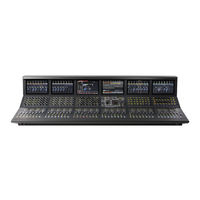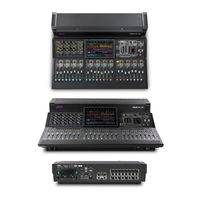Avid Technology S6L-16C Manuals
Manuals and User Guides for Avid Technology S6L-16C. We have 4 Avid Technology S6L-16C manuals available for free PDF download: System Manual, Replacing, Installing
Avid Technology S6L-16C System Manual (574 pages)
Brand: Avid Technology
|
Category: Music Mixer
|
Size: 10 MB
Table of Contents
-
Stage16
-
S6L-48D32
-
Stage32
-
S6L-32D33
-
S6L-24D34
-
S6L-24C35
-
S6L-16C36
-
Stage 4845
-
Local 1645
-
Resources47
-
Activation48
-
Fader Banks51
-
Channel Menu52
-
Channel Safe53
-
Mute54
-
Solo54
-
Select54
-
Attention55
-
Fader57
-
Meters View64
-
Usb96
-
E6L Front Panel101
-
E6L Back Panel102
-
Stage 64105
-
Stage 16106
-
Local 16106
-
I/O Card Slots108
-
How to Proceed134
-
How to Proceed143
-
User Layouts151
-
Layouts View157
-
Automix180
-
Using Automix180
-
20 Db Pad187
-
Phantom Power)188
-
Delay188
-
Polarity Invert192
-
Direct Outs192
-
Safe193
-
Eq Pre Dyn197
-
Sidechain201
-
Horizontal Mode208
-
Banking Vcas216
-
12 Matrix Mixers236
-
Mute Groups245
-
Soloing Channels259
-
Soloing Vcas261
-
Clearing Solos261
-
Overview268
-
Filing269
-
Snapshots269
-
Patchbay270
-
Plug-Ins270
-
Control271
-
Options271
-
Banner Display272
-
Type Text Search273
-
Universe View274
-
Sidechain282
-
Input Direct285
-
Naming Channels288
-
17 Filing302
-
Creating Shows302
-
Show Folders302
-
Show Files303
-
Loading a Show304
-
Preset Folders306
-
Preset Files307
-
Snapshots314
-
18 Snapshots315
-
Snapshots List316
-
Naming Snapshots323
-
Snapshot Groups329
-
Moving Snapshots338
-
Using Edit Mode339
-
Preview Mode341
-
Snapshot Options351
-
Crossfade Time352
-
Pre Settings353
-
User aux Scope353
-
Recall Safe359
-
Using Scope Sets364
-
19 Patchbay370
-
I/O Tabs371
-
Hardware Tabs371
-
Patching Grid372
-
Type Text Search380
-
20 Plug-Ins383
-
Plug-In Racks389
-
Rack Views390
-
Collapsed View391
-
Rack Slots395
-
Routing Plug-Ins398
-
Plug-In Levels409
-
Using Tap Tempo410
-
Events419
-
Terminology419
-
The Events Tab420
-
Event List421
-
Triggers422
-
Actions423
-
Creating Events424
-
Adding an Event425
-
Selecting Events425
-
Moving Events425
-
Smart Duplicate428
-
Events Presets433
-
Creating Actions438
-
Testing Events441
-
Resetting Events441
-
Default Events443
-
Examples444
-
Templates445
-
22 Options448
-
System448
-
System450
-
Troubleshooting452
-
VENUE Software454
-
Buses454
-
Auxiliaries454
-
Headphones455
-
Auto455
-
Primary Settings456
-
Hardware Inserts460
-
Snapshots460
-
Pre461
-
Time Code462
-
MIDI462
-
Misc462
-
Oscillator463
-
Talkback464
-
2-Track Inputs465
-
Tap Tempo466
-
System Clock466
-
Mouse466
-
Interaction467
-
Ethernet Control469
-
Metering469
-
Lights471
-
Devices472
-
Engine473
-
Hdx Dsp473
-
Network473
-
Information474
-
Plug-Ins476
-
Help476
-
Time Code493
-
Sending Audio499
-
Receiving Audio499
-
Using MADI499
-
Assignable Mode499
-
Assignable I/O500
-
Hardware Inserts500
-
Milan Mode504
-
AVB-HD Mode504
-
Milan Mode505
-
DB25F Pinout516
-
Problem Solving522
-
Utility Mode532
-
LED Brightness536
-
System Test538
-
Loopback Tests540
-
E6LX Engine549
-
E6L Engine550
-
Stage 64551
-
Stage 32553
-
Local 16 I/O555
-
E6L Engine556
Advertisement
Avid Technology S6L-16C Replacing (31 pages)
Replacing the SBC Motherboard
Brand: Avid Technology
|
Category: Music Mixer
|
Size: 10 MB
Avid Technology S6L-16C Installing (18 pages)
RAM Expansion
Brand: Avid Technology
|
Category: Music Mixer
|
Size: 7 MB
Table of Contents
Advertisement
Avid Technology S6L-16C Replacing (17 pages)
Brand: Avid Technology
|
Category: Music Mixer
|
Size: 5 MB



